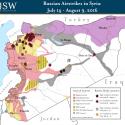 |
 |
Russian Airstrikes in Syria: July 14 - August 9, 2016
Aug 12, 2016 - Genevieve Casagrande


Russia intensified its air operations in and around Aleppo City after Syrian opposition groups lifted the regime’s blockade of the city’s eastern districts on August 6, demonstrating its continued commitment to bolster the regime in the Syrian Civil War. Russia continued to conduct strikes in Aleppo from July 28 – August 9 in support of the regime campaign to besiege Aleppo City and force the surrender of the primary stronghold of opposition factions acceptable to the West in Northern Syria. The opposition reestablished its ground line of communication (GLOC) leading out of the city on August 6, dealing a significant setback to Syrian President Bashar al-Assad in his attempt to capture Syria’s largest urban and commercial center. Russian warplanes subsequently intensified their airstrikes against opposition targets in eastern Aleppo City and villages along the M5 Aleppo – Damascus Highway in the southern Aleppo countryside, preventing civilians and humanitarian organizations from using the newly-established GLOC into the city. The targeted strikes also constrained the movement of opposition forces as they attempted to further consolidate control in the southwestern districts of Aleppo City. Russia’s continued use of air power against critical infrastructure and densely-populated terrain in Aleppo City follows U.S. President Barack Obama’s statement on August 4 that Russia’s “direct involvement” in support of regime operations to besiege the city has raised “very serious questions” about its commitment to a political resolution of the Syrian Civil War. Russia continues to prioritize the pursuit of pro-regime military objectives despite a recent proposal for partnership with the U.S. against ISIS and al-Qaeda in Syria. Russia is likely to continue to wage its air campaign in order to bolster pro-regime forces attempting to encircle the city, the surrender of which would pose an existential threat to the viability of the acceptable Syrian opposition in Northern Syria.
Russia also intensified its air operations against opposition targets in Idlib Province after an unidentified opposition group downed an Mi-8 Russian helicopter near the town of Saraqeb in northern Idlib on August 1, killing the five Russian military personnel on board. The downing of the helicopter marked the single deadliest event for Russia since its air campaign began in Syria on September 29, 2015. Russian warplanes conducted retaliatory airstrikes against several small opposition-held areas in the vicinity of Saraqeb from August 1 - 2 and targeted neighborhoods in Saraqeb from August 5 – 7. Local activist sources also reported that Russian jets dropped incendiary munitions while conducting airstrikes against Idlib City on August 7, suggesting that Russia intended to achieve punitive and deterrent effects against opposition forces in the province. Russia will likely continue to target core opposition-held terrain in Idlib Province in order to disrupt Idlib-based opposition forces massed in Aleppo. Russia also conducted airstrikes against ISIS-held terrain near the city of Palmyra in eastern Homs Province on August 7 following pro-regime deployments to Aleppo City from the Palmyra area. Russia likely aims to prevent ISIS advances against pro-regime forces in Palmyra as the regime is redeploying forces away from the area.
The following graphic depicts ISW’s assessment of Russian airstrike locations based on reports from local Syrian activist networks, statements by Russian and Western officials, and documentation of Russian airstrikes through social media. This map represents locations targeted by Russia’s air campaign, rather than the number of individual strikes or sorties.
High-Confidence reporting. ISW places high confidence in reports corroborated by documentation from opposition factions and activist networks on the ground in Syria deemed to be credible that demonstrate a number of key indicators of Russian airstrikes.
Low-Confidence reporting. ISW places low confidence in reports corroborated only by multiple secondary sources, including from local Syrian activist networks deemed credible or Syrian state-run media.
By Jonathan Mautner